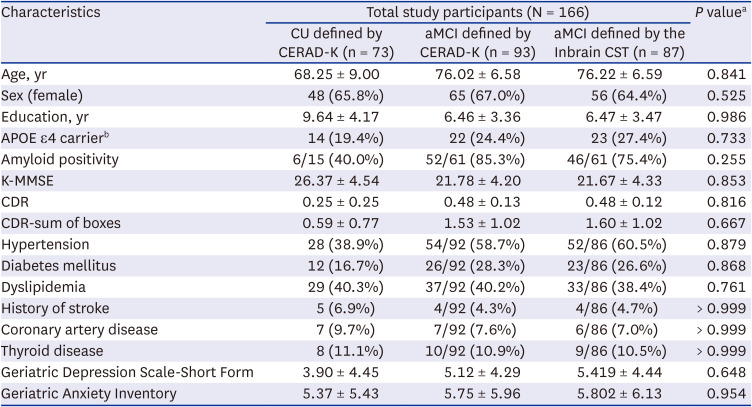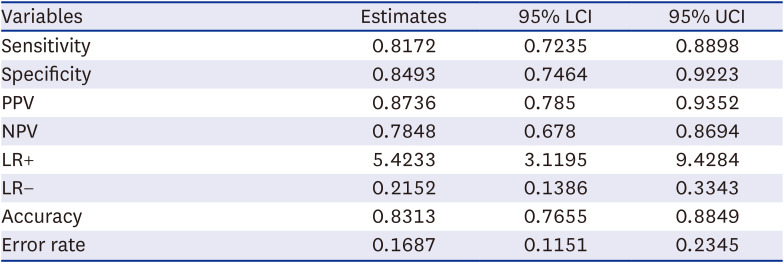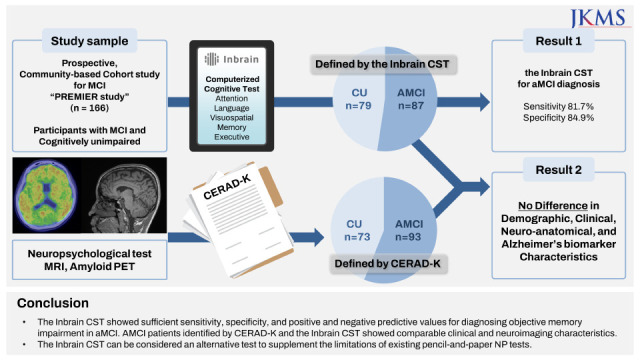1. Petersen RC. Mild cognitive impairment as a diagnostic entity. J Intern Med. 2004; 256(3):183–194. PMID:
15324362.

2. Dubois B, Albert ML. Amnestic MCI or prodromal Alzheimer’s disease? Lancet Neurol. 2004; 3(4):246–248. PMID:
15039037.

3. Adams JL, Myers TL, Waddell EM, Spear KL, Schneider RB. Telemedicine: a valuable tool in neurodegenerative diseases. Curr Geriatr Rep. 2020; 9(2):72–81. PMID:
32509504.

4. Chan JY, Yau ST, Kwok TC, Tsoi KK. Diagnostic performance of digital cognitive tests for the identification of MCI and dementia: a systematic review. Ageing Res Rev. 2021; 72:101506. PMID:
34744026.

5. Chin J, Kim DE, Lee H, Yun J, Lee BH, Park J, et al. A validation study of the Inbrain CST: a tablet computer-based cognitive screening test for elderly people with cognitive impairment. J Korean Med Sci. 2020; 35(34):e292. PMID:
32864906.

6. Jang H, Yeo M, Cho J, Kim S, Chin J, Kim HJ, et al. Effects of smartphone application-based cognitive training at home on cognition in community-dwelling non-demented elderly individuals: A randomized controlled trial. Alzheimers Dement (N Y). 2021; 7(1):e12209. PMID:
35005202.

7. Lee JH, Lee KU, Lee DY, Kim KW, Jhoo JH, Kim JH, et al. Development of the Korean version of the Consortium to Establish a Registry for Alzheimer’s Disease Assessment Packet (CERAD-K): clinical and neuropsychological assessment batteries. J Gerontol B Psychol Sci Soc Sci. 2002; 57(1):47–53.

8. Lim HK, Hong SC, Jung WS, Ahn KJ, Won WY, Hahn C, et al. Automated hippocampal subfield segmentation in amnestic mild cognitive impairments. Dement Geriatr Cogn Disord. 2012; 33(5):327–333. PMID:
22759884.
9. Qiu A, Bitouk D, Miller MI. Smooth functional and structural maps on the neocortex via orthonormal bases of the Laplace-Beltrami operator. IEEE Trans Med Imaging. 2006; 25(10):1296–1306. PMID:
17024833.

10. Vallet B, Lévy B. Spectral geometry processing with manifold harmonics. Comput Graph Forum. 2008; 27(2):251–260.

11. Jack CR Jr, Wiste HJ, Weigand SD, Knopman DS, Mielke MM, Vemuri P, et al. Different definitions of neurodegeneration produce similar amyloid/neurodegeneration biomarker group findings. Brain. 2015; 138(Pt 12):3747–3759. PMID:
26428666.

12. Rugg MD, Otten LJ, Henson RN. The neural basis of episodic memory: evidence from functional neuroimaging. Philos Trans R Soc Lond B Biol Sci. 2002; 357(1424):1097–1110. PMID:
12217177.

13. Parra MA, Abrahams S, Fabi K, Logie R, Luzzi S, Della Sala S. Short-term memory binding deficits in Alzheimer’s disease. Brain. 2009; 132(Pt 4):1057–1066. PMID:
19293236.

14. Wilkins CH, Windon CC, Dilworth-Anderson P, Romanoff J, Gatsonis C, Hanna L, et al. Racial and ethnic differences in amyloid PET positivity in individuals with mild cognitive impairment or dementia: a secondary analysis of the Imaging Dementia–Evidence for Amyloid Scanning (IDEAS) cohort study. JAMA Neurol. 2022; 79(11):1139–1147. PMID:
36190710.

15. Landau SM, Horng A, Fero A, Jagust WJ. Alzheimer’s Disease Neuroimaging Initiative. Amyloid negativity in patients with clinically diagnosed Alzheimer disease and MCI. Neurology. 2016; 86(15):1377–1385. PMID:
26968515.

16. Ho S, Hong YJ, Jeong JH, Park KH, Kim S, Wang MJ, et al. Study design and baseline results in a cohort study to identify predictors for the clinical progression to mild cognitive impairment or dementia from subjective cognitive decline (CoSCo) study. Dement Neurocogn Disord. 2022; 21(4):147–161. PMID:
36407288.

17. Janssen O, Jansen WJ, Vos SJB, Boada M, Parnetti L, Gabryelewicz T, et al. Characteristics of subjective cognitive decline associated with amyloid positivity. Alzheimers Dement. 2022; 18(10):1832–1845. PMID:
34877782.

18. Park HK, Na DL, Han SH, Kim JY, Cheong HK, Kim SY, et al. Clinical characteristics of a nationwide hospital-based registry of mild-to-moderate Alzheimer’s disease patients in Korea: a CREDOS (Clinical Research Center for Dementia of South Korea) study. J Korean Med Sci. 2011; 26(9):1219–1226. PMID:
21935279.

19. Aisen PS, Petersen RC, Donohue MC, Gamst A, Raman R, Thomas RG, et al. Clinical core of the Alzheimer’s disease neuroimaging initiative: progress and plans. Alzheimers Dement. 2010; 6(3):239–246. PMID:
20451872.

20. Jak AJ, Bondi MW, Delano-Wood L, Wierenga C, Corey-Bloom J, Salmon DP, et al. Quantification of five neuropsychological approaches to defining mild cognitive impairment. Am J Geriatr Psychiatry. 2009; 17(5):368–375. PMID:
19390294.

21. Jessen F, Wolfsgruber S, Wiese B, Bickel H, Mösch E, Kaduszkiewicz H, et al. AD dementia risk in late MCI, in early MCI, and in subjective memory impairment. Alzheimers Dement. 2014; 10(1):76–83. PMID:
23375567.

22. Edmonds EC, McDonald CR, Marshall A, Thomas KR, Eppig J, Weigand AJ, et al. Early versus late MCI: improved MCI staging using a neuropsychological approach. Alzheimers Dement. 2019; 15(5):699–708. PMID:
30737119.

23. Grill JD, Nuño MM, Gillen DL. Alzheimer’s Disease Neuroimaging Initiative. Which MCI patients should be included in prodromal Alzheimer disease clinical trials? Alzheimer Dis Assoc Disord. 2019; 33(2):104–112. PMID:
30958413.








 PDF
PDF Citation
Citation Print
Print




 XML Download
XML Download